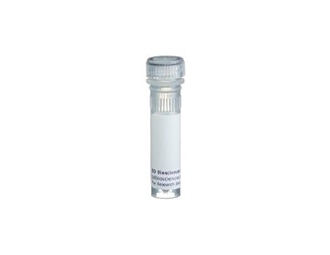Old Browser
This page has been recently translated and is available in French now.
Looks like you're visiting us from {countryName}.
Would you like to stay on the current country site or be switched to your country?


Regulatory Status Legend
Any use of products other than the permitted use without the express written authorization of Becton, Dickinson and Company is strictly prohibited.
Preparation And Storage
Product Notices
- Since applications vary, each investigator should titrate the reagent to obtain optimal results.
- Please refer to www.bdbiosciences.com/us/s/resources for technical protocols.
- Caution: Sodium azide yields highly toxic hydrazoic acid under acidic conditions. Dilute azide compounds in running water before discarding to avoid accumulation of potentially explosive deposits in plumbing.
The 6A8.6F10.1A6 monoclonal antibody reacts with the Qa-1[b] alloantigen, which is a nonclassical MHC class I (Class Ib) molecule encoded by the T23 gene of the H-2 complex (H2-T23). Qa-1 associates with β2-microglobulin and is expressed at low levels on most leukocytes and many other cell types. Its level of cell-surface expression is upregulated by IFNγ or specific peptides. Qa-1 is an oligomorphic molecule which presents a limited pool of peptides to T lymphocytes bearing αβ and γδTCR and binds to a large subpopulation of NK cells. In fact, Qa-1[b] is the ligand for CD94/NKG2A, CD94/NKG2C, and CD94/NKG2E receptors, which are expressed on NK cells. Furthermore, it has been reported that Qa-1 expressed on activated B lymphocytes is involved in immunoregulation by inducing T-cell-mediated suppression of antibody responses. The 6A8.6F10.1A6 mAb can detect Qa-1[b] on activated splenocytes from C57BL/6 and BALB/c mice (both Qa-1[b]), but not from A/j mice (Qa-1[a]), and it can block target cell recognition by CTLs specific for Qa-1-presented antigen.
Development References (8)
-
BD Biosciences Pharmingen. Unpublished results. .
-
Lo WF, Ong H, Metcalf ES, Soloski MJ. T cell responses to Gram-negative intracellular bacterial pathogens: a role for CD8+ T cells in immunity to Salmonella infection and the involvement of MHC class Ib molecules. J Immunol. 1999; 162(9):5398-5406. (Immunogen). View Reference
-
Noble A, Zhao ZS, Cantor H. Suppression of immune responses by CD8 cells. II. Qa-1 on activated B cells stimulates CD8 cell suppression of T helper 2 responses. J Immunol. 1998; 160(2):566-571. (Biology). View Reference
-
Salcedo M, Bousso P, Ljunggren HG, Kourilsky P, Abastado JP. The Qa-1b molecule binds to a large subpopulation of murine NK cells. Eur J Immunol. 1998; 28(12):4356-4361. (Biology). View Reference
-
Sivakumar PV, Gunturi A, Salcedo M, et al. Cutting edge: expression of functional CD94/NKG2A inhibitory receptors on fetal NK1.1+Ly-49- cells: a possible mechanism of tolerance during NK cell development. J Immunol. 1999; 162(12):6976-6980. (Biology). View Reference
-
Soloski MJ, DeCloux A, Aldrich CJ, Forman J. Structural and functional characteristics of the class IB molecule, Qa-1. Immunol Rev. 1995; 147:67-89. (Biology). View Reference
-
Vance RE, Jamieson AM, Raulet DH. Recognition of the class Ib molecule Qa-1(b) by putative activating receptors CD94/NKG2C and CD94/NKG2E on mouse natural killer cells. J Exp Med. 1999; 190(12):1801-1812. (Biology). View Reference
-
Vance RE, Kraft JR, Altman JD, Jensen PE, Raulet DH. Mouse CD94/NKG2A is a natural killer cell receptor for the nonclassical major histocompatibility complex (MHC) class I molecule Qa-1(b). J Exp Med. 1998; 188(10):1841-1848. (Biology). View Reference
Please refer to Support Documents for Quality Certificates
Global - Refer to manufacturer's instructions for use and related User Manuals and Technical data sheets before using this products as described
Comparisons, where applicable, are made against older BD Technology, manual methods or are general performance claims. Comparisons are not made against non-BD technologies, unless otherwise noted.
For Research Use Only. Not for use in diagnostic or therapeutic procedures.
Report a Site Issue
This form is intended to help us improve our website experience. For other support, please visit our Contact Us page.
.png?imwidth=320)